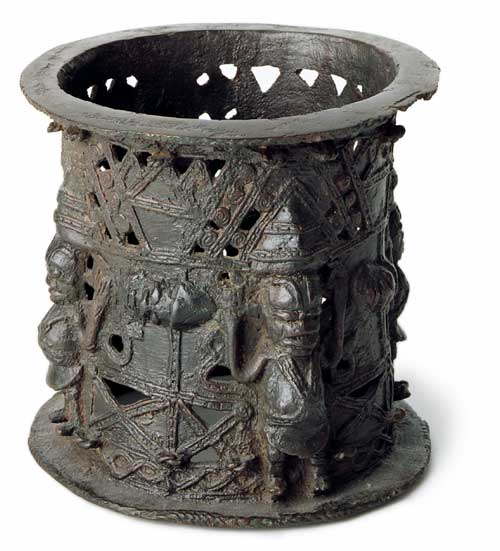Galerie Peter Herrmann |
- | Ancient Art from Africa |
||
 |
| Arm Cuff | Thermoluminescence- Expertise |
| Benin, Nigeria 18th. century Bronze 12 x 13 cm |
 |
| edited since 2008 old german collection 1960 |
Arm Cuff: |
In addition to the various patterns that ornament this arm cuff, four standing figures with peaked headdress alternate with horizontally-positioned - most likely sacrificial - heads. Stylistically considered, this piece cannot be definitively placed; but at the very least, a formal affinity to Benin is unmistakable. In a similar arm cuff discussed in the Viennese Catalogue, Kathy Curnow sees references to the Yoruba, particularly to the Ijebu Yoruba. She argues that the work raises interesting questions regarding the historical and artistic relation of Benin to the Yoruba. She even goes so far as to suggest that the work was not cast in Benin, but rather by Ijebu metal workers for buyers in Benin. Given that our cuff, despite small variations, is stylistically much more closely related to Benin than to the piece considered by Curnow , the applicability of this thesis seems questionable. Curnow also challenges the function of the object as arm cuff, noting that similar objects in ancestral shrines were used as stands for bowls and other dishes. Cp.: |
| Similar objects : | Illustration : |
| Staatliche Museen zu Berlin - Ethnologisches Museum | Barbara PLANKENSTEINER (Hg.): Benin. Könige und Rituale. Höfische Kunst aus Nigeria, Wien 2007, S. 274. |
| Felix von LUSCHAN: Die Altertümer von Benin, Band 3, Berlin 1919, Tafel 99. |
| Pitt Rivers Museum, Oxford | Augustus Henry PITT-RIVERS: Antique Works of Art from Benin, London 1900 (Reprint in New York 1976), Abb. 128. |